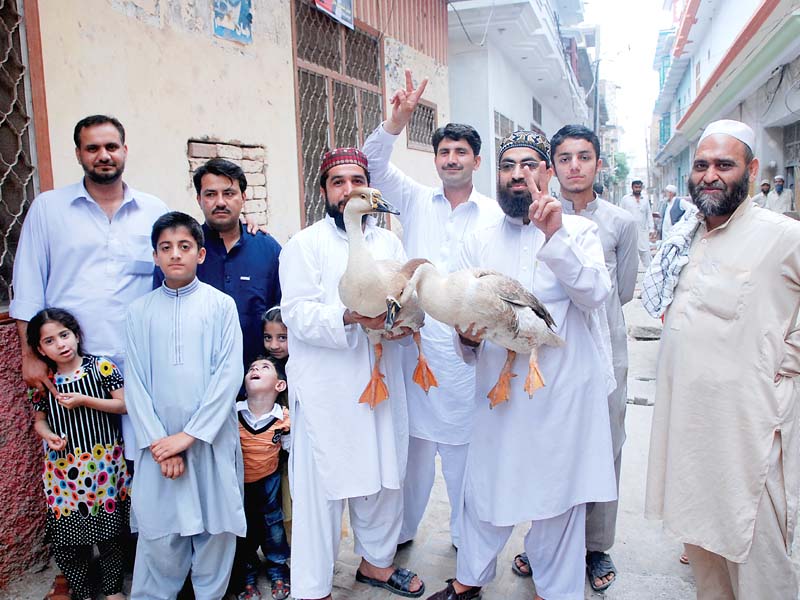
Winging it
Symbols allotted to LG candidates have their feathers in a ruffle – a duck, a mouse, a nut and a bottle, how far will these aspirants go? Quite far as it seems there are people who are using more innovative ways of campaigning, using popular symbols to cash in on the vote bank.
In a narrow alley on Kohat Road near Indus Highway, a cluster of men and children have gathered around Qari Ziaur Rehman Sabir as he makes one of many election speeches. But the crowd is less interested in his talking points; they’re drawn to two lovely feathered creatures with webbed feet, a part of the candidate’s entourage.
And this pair of geese can quack louder than the candidate can campaign.
“I had to travel all the way to Charsadda and pay four thousand rupees for a pair of geese,” says Sabir.
An independent candidate, Sabir belongs to a religious family which runs a seminary. The amusement of his audience is obvious.
Although he is forced to carry the birds in his arms along with his brother for most of the journey, his feathered entourage attracts more people to listen to what he has to say. Sabir was allotted a duck as a symbol but he chose geese as they would be more “aesthetically appealing” to his audience.
Liquid courage
His opposing candidate, Fazal Rehman, was initially worried about Sabir’s campaign and the interest his quacking expedition would generate and how that would translate into votes. To top it all, Rehman says, the symbol allotted to him was a bottle but then he put on his thinking cap.
The result has been an equally challenging repartee to Sabir’s campaigners. Rehman campaign team is now on the move with bottled cold drinks, offering a much-needed respite from the heat.
In a country with widespread illiteracy, election symbols used by political parties and candidates are vitally important to the people’s unalienable right to choose their representatives. But decisions on how to campaign with ill-thought symbols are not as easy to take as they seem.
In the ghettos alongside the railway track on GT Road, a large migrant population from the tribal areas resides.
Gul Rehman of Mohmand Agency—now a resident of Peshawar—remains busy scrolling through electoral rolls, marking out his extended tribe as his confirmed votes. But the problem he faces is quite explosive, literally.
The symbols allotted locally include both an oil stove versus a gas stove. “It’s impossible to explain the difference between the two to our voters,” he says.
Another candidate from the area says his voters, who are mostly women, cannot relate to a photocopy machine (another symbol) and they have to first train the women in their house to go out explain the mark of their campaign to other women.
Beyond the politicking and complexities of the electoral process, these campaigns have restored the city’s nightlife. And be it about a duck or a bottle, candidates are seen campaigning way past midnight. In a city that has lost much of it social life, many see the electioneering process as a light in the dark.
“It’s for the first time in years that I have seen my neighbours,” says Wahid Khan, “Otherwise a dead silence meanders on these streets after dark.”
Published in The Express Tribune, May 12th, 2015.
1725967717-0/Untitled-design-(3)1725967717-0-405x300.webp)

1725275251-0/Untitled-design-(3)1725275251-0-165x106.webp)

1720097164-0/BeFunky-collage-(9)1720097164-0-165x106.webp)






COMMENTS (2)
Comments are moderated and generally will be posted if they are on-topic and not abusive.
For more information, please see our Comments FAQ